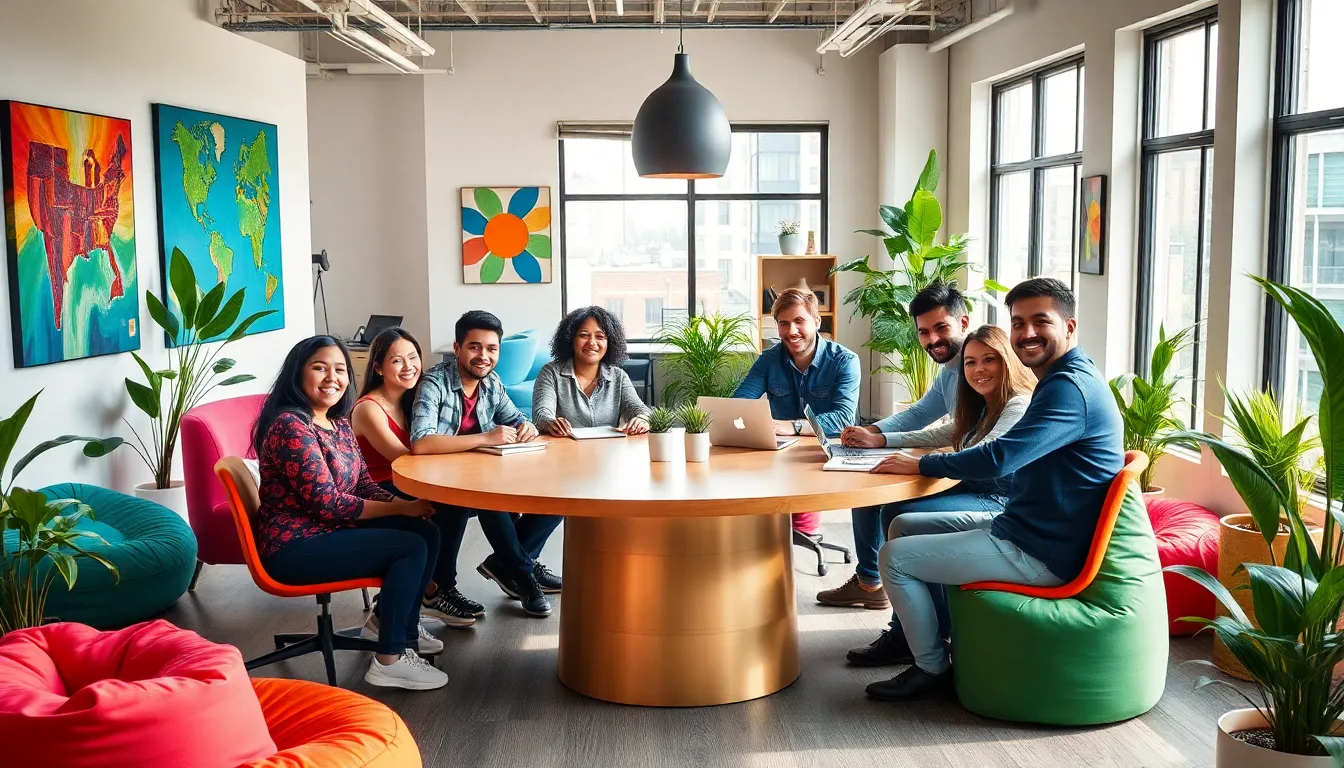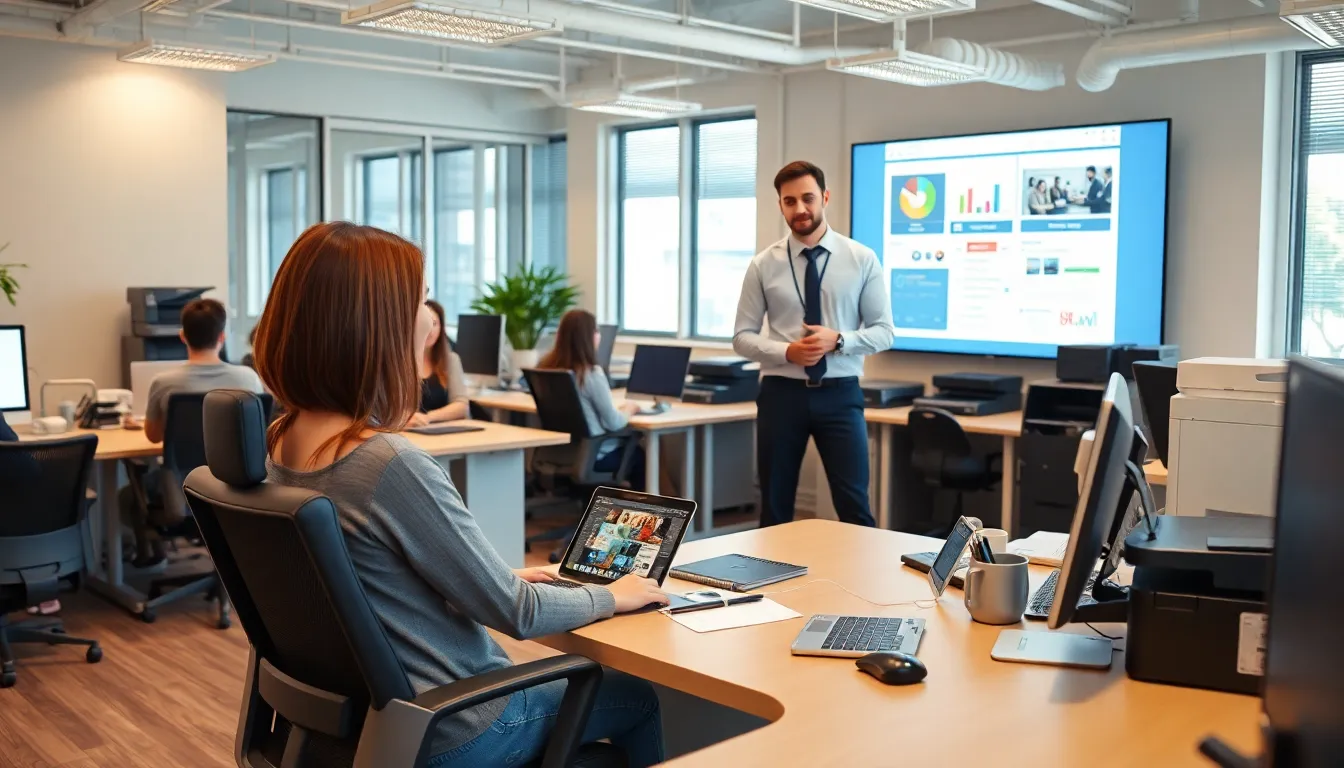Table of Contents
ToggleIn a world where the traditional cubicle reigns supreme, creative office spaces are shaking things up and redefining how we work. Gone are the days of dreary gray walls and uninspiring desks. Today’s workplaces are vibrant, innovative, and designed to spark creativity. Imagine brainstorming in a cozy nook with bean bags or collaborating over coffee in a sunlit lounge—sounds way better than that fluorescent-lit dungeon, right?
Creative office spaces aren’t just about aesthetics; they’re about boosting productivity and employee satisfaction. When teams feel inspired, they produce their best work. So why settle for boring when you can transform your workspace into a playground of ideas? Let’s dive into the world of creative office spaces and discover how they can elevate the work experience while keeping those creative juices flowing.
Overview Of Creative Office Space
Creative office spaces focus on flexibility and innovation. These environments often blend work and play, fostering collaboration and interaction among employees. Features like open floor plans, breakout areas, and themed meeting rooms invite spontaneity and creative thinking. Natural light plays a crucial role; it enhances mood and productivity levels.
Design elements such as vibrant colors, unique furniture, and art installations inspire creativity. These aspects not only enhance aesthetic appeal but also promote a sense of belonging and identity within the workspace. Incorporating greenery through plants or natural elements further benefits employee well-being and concentration.
Technology integration is vital in creative office spaces. Wireless connectivity and smart office tools streamline workflows and improve communication. This tech enhances efficiency and enables employees to adapt their work environments to their specific needs.
Establishing community hubs within the office encourages networking and relationship building. Coworking spaces and lounges allow team members to share ideas and collaborate on projects. Companies implementing these designs report higher employee engagement and satisfaction levels.
A recent report shows that 72% of employees claim work environment affects their performance. Innovative office designs contribute significantly to attracting and retaining top talent. By focusing on creative office spaces, organizations can create dynamic environments that drive growth and elevate work experiences.
Benefits Of Creative Office Space

Creative office spaces provide numerous advantages that significantly enhance workplace dynamics. These environments promote interaction and creativity, ultimately leading to improved performance and satisfaction.
Enhancing Collaboration
Collaboration thrives in creative office spaces. Open layouts and designated breakout areas encourage spontaneous discussions. Teams engage more effectively, utilizing shared spaces designed for brainstorming and teamwork. The flexibility provided by varied seating arrangements and meeting rooms fosters an inclusive feeling. Access to shared technology simplifies communication and workflow. As a result, cross-departmental collaboration flourishes, creating a cohesive atmosphere that drives innovation.
Boosting Employee Morale
Employee morale experiences a notable boost in these vibrant settings. Comfortable spaces equipped with natural light contribute to overall well-being. Unique design elements, like colorful decor and artwork, instill a sense of belonging. Cozy lounges and inviting communal areas provide employees with a sanctuary to recharge. Studies indicate that 72% of employees feel healthier and more motivated when surrounded by creative environments. Consequently, organizations that invest in creative spaces see increased job satisfaction, retention rates, and overall team enthusiasm.
Design Elements Of Creative Office Space
Creative office spaces utilize various design elements to boost productivity and enhance employee satisfaction. Flexible layouts and inspirational decor play significant roles.
Flexible Work Areas
Flexible work areas cater to diverse working styles. They offer a variety of seating arrangements and collaborative zones, allowing employees to choose where they feel most productive. For example, quiet zones provide solitude for focused tasks, while communal spaces encourage teamwork and brainstorming. This adaptability supports spontaneous interactions and fosters a culture of collaboration. Desks with adjustable heights accommodate individual preferences, promoting comfort and health. Overall, these areas enhance functionality and engagement within the workplace.
Inspirational Decor
Inspirational decor sets the tone for creativity and innovation. Bright colors stimulate energy, while unique artwork invites exploration and conversation. Wall murals can visually represent company values or inspire new ideas among employees. Incorporating local artists’ work connects the workspace to its community, enhancing cultural relevance. Similarly, incorporating plants improves air quality and brings elements of nature indoors, promoting well-being. Each decor choice contributes to an environment where employees feel invested and inspired, ultimately driving performance and satisfaction.
Case Studies Of Successful Creative Office Spaces
Examples of successful creative office spaces abound, showcasing innovative designs that enhance productivity and employee satisfaction. These case studies highlight how companies embrace unique layouts and vibrant aesthetics to foster creativity.
Innovative Companies Leading The Way
Google exemplifies a commitment to creativity with its open workspaces, themed meeting rooms, and collaborative areas. Employees enjoy access to game rooms, nap pods, and active areas that encourage spontaneity. Airbnb also stands out with its design inspired by travel, featuring diverse work zones that reflect global cultures. Employees thrive in spaces that embody the company’s core values, promoting connection and innovation. Dropbox utilizes bright colors and artwork to create an inviting atmosphere, blending work with leisure, which boosts morale and productivity.
Lessons Learned From Transformations
Companies that have transformed their office environments consistently report enhanced employee engagement. A significant example is WeWork, which redefined typical office spaces through flexible layouts and communal areas, fostering collaboration. Transformations lead to higher satisfaction rates, with studies indicating that 72% of employees feel healthier in vibrant environments. Effective redesigns often incorporate natural light and greenery, which improve well-being and concentration. These lessons underline how thoughtful design choices positively impact workplace dynamics and contribute to business success.
Challenges In Implementing Creative Office Space
Creative office spaces provide numerous benefits, but they also present challenges. Organizations face various obstacles when attempting to implement these innovative designs.
Budget Considerations
Budget constraints significantly influence the implementation of creative office spaces. Initial costs for renovating an office can be high, particularly when investing in quality furnishings and advanced technology. Many companies prioritize functionality while also aiming for aesthetic appeal, leading to complex financial decisions. Opting for unique designs may require reallocation of funds from other budget areas, potentially limiting other essential improvements. It’s crucial for organizations to strike a balance between innovative design and budget restrictions to ensure long-term sustainability.
Balancing Functionality And Aesthetics
Balancing functionality and aesthetics proves challenging in creative office spaces. In some instances, visually appealing environments can compromise essential operational needs. Open layouts often enhance collaboration but may limit privacy for employees. Striking the right balance involves understanding team dynamics and specific work functions. Multifunctional spaces help address this issue by incorporating areas for focus alongside collaborative zones. Prioritizing both aesthetics and practicality leads to an environment that fosters creativity without sacrificing productivity.
Creative office spaces are more than just a trend; they represent a fundamental shift in how organizations approach work environments. By prioritizing design elements that promote collaboration and well-being, companies can significantly enhance employee satisfaction and productivity.
Investing in vibrant and flexible workspaces not only attracts top talent but also fosters a culture of innovation. As businesses continue to adapt to changing needs, embracing creative office designs will be crucial for driving growth and maintaining a motivated workforce.
Ultimately, the right office environment can transform daily operations, making work feel less like a chore and more like an inspiring journey.



